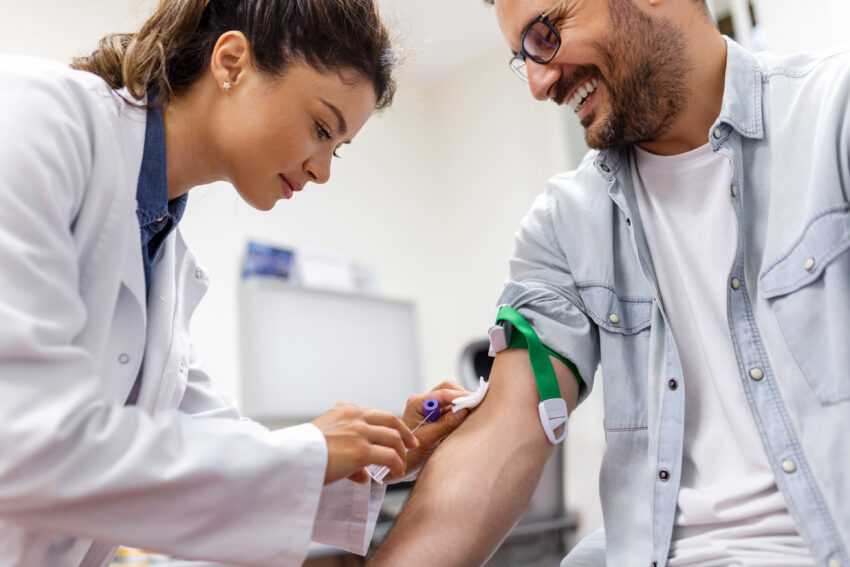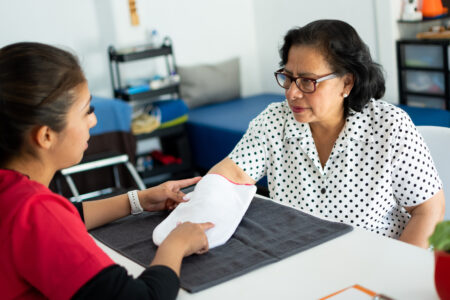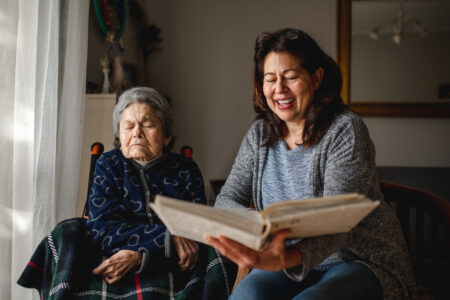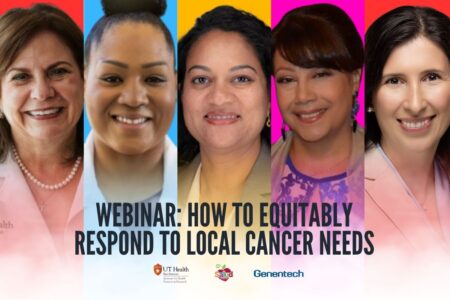
Share On Social!
The last thing a person wants to hear from their doctor is “You have cancer.”
Unfortunately, that’s the reality for the thousands of Americans, including many Latinos, diagnosed with cancer each year.
After a diagnosis, people dealing with cancer discuss treatment options with their medical care team, which may include participation in clinical trials.
Clinical trials are studies with volunteers that test ways to find, prevent, and treat cancer and other diseases. They may also help improve the quality of life for volunteers affected by cancer or reduce the side effects of treatment.
Despite the benefits of participating in clinical trials, only about one out of every five (21.9%) people with cancer enroll in clinical research, according to a new study in the Journal of Clinical Oncology led by the American Cancer Society Cancer Action Network, Fred Hutchinson Cancer Center, and others.
Study Findings on Clinical Trial Participation
While clinical trials have historically had difficulty enrolling participants, especially diverse participants such as Latinos, participation in cancer treatment clinical trials is on the rise.
The study revealed that enrollment in cancer treatment trials was 7.1%, which is more than double the previous estimates of 2% to 3%.
Additionally, the enrollment in treatment trials was five times higher at National Cancer Institute Cancer Centers than at community sites, 21.6% and 4.1% respectfully.
“We know that most patients with cancer will participate in a clinical trial if given the chance, and the level of enrollment we see at NCI-designated cancer centers shows what participation can be when patients are offered trials,” said Dr. Mark Fleury, a policy principle at ACS CAN and senior author of the study. “These findings emphasize the need to offer more patients in community settings the chance to participate and that will require an investment in these sites that currently isn’t there.”
The study, which included analysis from 70% of people diagnosed with cancer each year in the US, looked at multiple types of clinical trials and considered tissue sample contributions and quality-of-life studies.
The results were as followed:
- 13% provide samples for biorepositories.
- 7% participate in treatment trials.
- 7% signed up for cancer registries.
- 4% participate in genetic studies.
- 3% participate in quality-of-life studies.
- 3% enroll in diagnostic studies.
- 2% take part in economic studies.
“As we work to increase participation in cancer research studies and make them more accessible to patients, we need an inclusive, accurate assessment of current participation to inform these policies,” said Dr. Joseph Unger, a health services researcher and biostatistician at Fred Hutch and lead author of the study.
“While we knew that patients play a significant role in advancing all types of cancer research, now we better understand just how commonly people are participating in all types of cancer studies today.”
Barriers to Clinical Trial Participation
There are hundreds of clinical trials available to people facing cancer. However, some of these open trials are out of reach for one reason or another.
This is why Drs. Amelie G. Ramirez and Patricia Chalela of UT Health San Antonio identified barriers to Latino representation in clinical trials in a recent commentary.
One such barrier that keeps people from enrolling in clinical trials is distance.
Where a person lives can determine their access to clinical trials.
Many clinical trials are based out of cancer facilities and hospitals, which are generally located in more populated areas, requiring many participants to travel to get there.
Those without reliable access to transportation are at a disadvantage, especially if the trial requires multiple follow-up visits.
Latinos are less likely to have access to a car than their white peers (12% vs. 6.5%), and more likely to rely on public transit (27% daily/weekly usage vs. 14%), according to a research review by Salud America! at UT Health San Antonio.
Distrust, Lack of Information, and Other Barriers to Clinical Trial Participation
Another big hurdle is that many participants must overcome is the distrust of researchers and research institutions.
Two of the most underrepresented groups in clinical research are women and minority groups, such as Latinos.
Much of the underrepresentation is based on factors such as history, education, culture, language, socioeconomic status, geography, racial identity, prejudice, and paternalism, according to the National Institutes of Health’s Office of Research on Women’s Health.
“Minority communities still strongly believe that participating in a clinical trial could actually worsen one’s health status or stigmatize the group in which an individual belongs,” NIH said.

Lack of knowledge surrounding clinical trials and the importance behind them seems to also keep potential participants at bay.
NIH cited a study involving Chinese American women cancer patients that found that 62% lacked knowledge of clinical trials and many had negative attitudes toward trials.
In another study cited by NIH, Latinas facing breast cancer didn’t acknowledge the effect breast cancer has on their community, which may have spawned low trial participation.
“Another significant issue is lack of knowledge among people about informed consent procedures and protections. A finding from a study involving pregnant women adds to the growing body of evidence that a gap exists between participants’ understanding and researchers’ perception of that understanding,” according to NIH.
For minorities, language remains one of the biggest barriers to clinical trial participation.
A lack of translated materials, feeling intimidated by the English language, and not having aa translation of key words necessary to understand the important aspects of the trial can contribute to low participation.
“Researchers identified language as affecting study recruitment and reported difficulty in obtaining interpreters and lack of sufficient bilingual staff that could recruit potential participants who spoke only Spanish,” NIH said.
What’s more, the study cited by NIH concluded that some women were more likely to participate in a clinical trial recommended by a trusted oncologist or by a fellow woman who provided them with information in their language.
This observation only seeks to reinforce the importance of the role bilingual patient advocates play in their patient’s care and treatment.
Increasing Diverse Clinical Trial Participation
Having diversity within clinical trials is essential to the creation of treatments and care that works for everyone, Ramirez said in her commentary.
“To achieve equitable participation of Latinos and other underrepresented groups in clinical research, we need comprehensive approaches that address social and contextual barriers to participation,” Ramirez said. “These can produce a substantial, sustained impact. And they can ensure everyone equitably benefits from scientific advances in cancer treatment, improved cancer outcomes, and reduced health care costs.”
To achieve higher enrollment of Latinos and other underrepresented groups, it’s all about restoring trust in the healthcare system through positive interactions with the patient’s medical team, said Dr. Marcella Mazo-Canola during the “How to Encourage Latinos to Participate in Clinical Trials” webinar.
“I think building that trust is key … Sitting down with your patient, talking about their life … interacting … getting to know them for them to get to the point that they trust you and that they respect you. I think that’s going to put you with your patient at the same level and that’s going to translate into many benefits for the patient … they’re going to be more likely to trust you when you are offering a clinical trial to help them,” Mazo-Canola said.
Many Latinos may not even be aware that clinical trials are an option for them.
Having those open discussions with their healthcare team is crucial to boosting participation, according to Mazo-Canola.
To address the lack of knowledge of clinical trials, Mazo-Canola emphasized the need for public clinical trial education and outreach.
One of the ways to do this is going out into the community and speaking to younger generations on the misconceptions and stigmas behind clinical trials.
When speaking about the hesitancy in joining a clinical trial, Mazo-Canola said that acknowledging the patient’s fears can go a long way.
“We can be afraid of not knowing what to expect or what things are going to happen, and I think it really comes down to acknowledging the fear and telling the patient, ‘It’s okay to be scared. This is a difficult situation and we’re going to be there for you, to guide you, and to help you,” she explained.
Lastly, explaining the benefits of a clinical trial can have a huge impact on someone’s decision to enroll in one.
Yet it really takes a systemic approach to addressing multiple barriers.
“Research has shown that the most effective strategies to increase participation of underrepresented minorities in [clinical trials] include culturally sensitive educational tools aimed at community members, patients, and physicians, and strategies to address the multiple [social determinants of health] and other barriers to participation facing cancer patients and the factors that influence patient decision-making,” according to Ramirez’s commentary.
Find a Clinical Trial Near You
Ramirez is leading the charge to increase clinical trial access to members of the Latino community by partnering with Genentech, a member of the Roche Group.
Part of that mission includes her work with Salud America!, which is showcasing open clinical trials and sharing the stories of those who enrolled in them.
Alma Lopez, who was diagnosed with breast cancer over 15 years ago, shared how participating in a clinical trial at UT Health San Antonio helped her with treatment.
“Clinical trials are great for finding new treatments that help people,” Lopez said. “And it helps the scientists. It gives opportunity to better medication for all populations. It builds a better future.”
In addition, Dr. Ramirez is also engaging with the community by hosting social media events, webinars, and more.
The latest webinar, which is part of the series, “Let’s Address Health Equity Together,” will take a deeper look at “How to Identify and Equitably Respond to Local Cancer Needs.”
Panelists, which include experts from the Mays Cancer Center at UT Health San Antonio, Moffitt Cancer Center in Florida, and Genentech, will break down the methods used to listen, engage, and respond to local cancer needs to guide cancer research, care, and outreach tailored to address the needs of local communities.
The webinar is scheduled to take place at 10 a.m. Central on Thursday, April 25, 2024.
To find a clinical trial, visit the Salud America! clinical trials page.
In San Antonio, search the Mays Cancer Center at UT Health San Antonio’s Find a Clinical Trial database to learn more about available clinical trials and eligibility requirements.
By The Numbers
10
Percent
of clinical trial participants are Latinos



